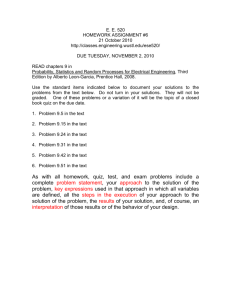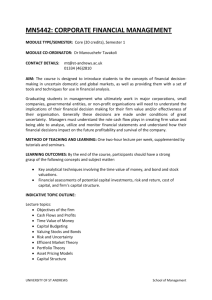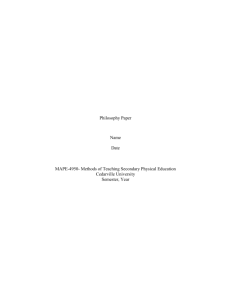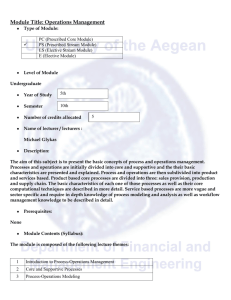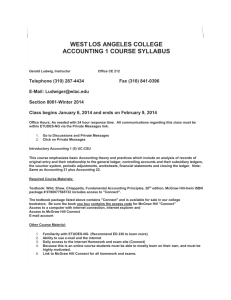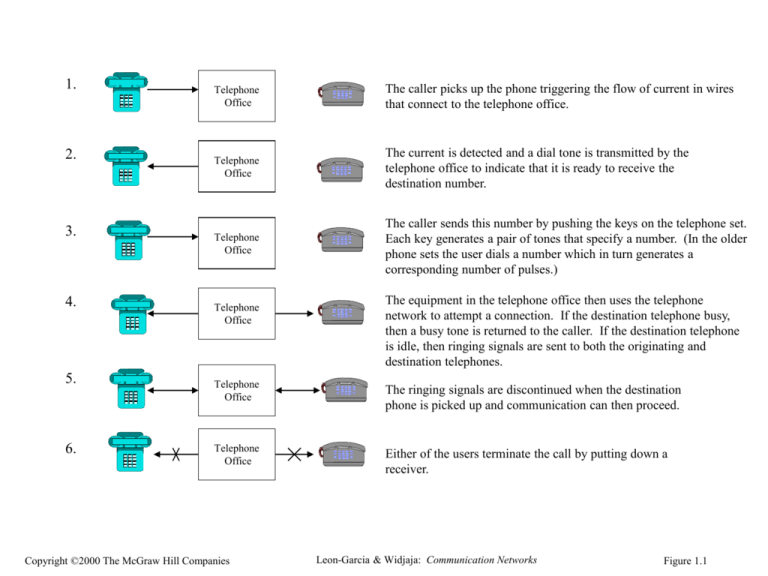
1.
2.
3.
4.
5.
6.
Telephone
Office
The caller picks up the phone triggering the flow of current in wires
that connect to the telephone office.
Telephone
Office
The current is detected and a dial tone is transmitted by the
telephone office to indicate that it is ready to receive the
destination number.
Telephone
Office
The caller sends this number by pushing the keys on the telephone set.
Each key generates a pair of tones that specify a number. (In the older
phone sets the user dials a number which in turn generates a
corresponding number of pulses.)
Telephone
Office
The equipment in the telephone office then uses the telephone
network to attempt a connection. If the destination telephone busy,
then a busy tone is returned to the caller. If the destination telephone
is idle, then ringing signals are sent to both the originating and
destination telephones.
Telephone
Office
The ringing signals are discontinued when the destination
phone is picked up and communication can then proceed.
Telephone
Office
Either of the users terminate the call by putting down a
receiver.
Copyright ©2000 The McGraw Hill Companies
Leon-Garcia & Widjaja: Communication Networks
Figure 1.1
• Transportation Network
Transport
Passengers
Produce
Freight
Solid
Liquid
Specialty
Transport Vehicle
Personal Automotives
Cars
Trucks
Minivans
Busses
Tractor Trailers
Transportation
City streets
Highways
Interstates
Copyright ©2000 The McGraw Hill Companies
Leon-Garcia & Widjaja: Communication Networks
1.
2.
3.
4.
5.
6.
Copyright ©2000 The McGraw Hill Companies
The user clicks on a link to indicate which document is to be
retrieved.
The browser must determine the address that contains the
document. It does this by sending a query to its local name
server.
Once the address is known the browser establishes a connection to the
specified machine, usually a TCP connection. In order for the
connection to be successful, the specified machine must be ready to
accept TCP connections.
The browser runs a client version of HTTP, which issues a request
specifying both the name of the document and the possible document
formats it can handle.
The machine that contains the requested document runs a server
version of HTTP. It reacts to the HTTP request by sending an
HTTP response which contains the desired document in the
appropriate format.
The TCP connection is then closed and the user may view
the document.
Leon-Garcia & Widjaja: Communication Networks
Figure 1.4
Realplayer example
Copyright © 1995-2000, RealNetworks, Inc. All rights reserved. RealPlayer is a trademark
of RealNetworks, Inc.
Copyright ©2000 The McGraw Hill Companies
Leon-Garcia & Widjaja: Communication Networks
Figure 1.5
t1
t0
Network
Copyright ©2000 The McGraw Hill Companies
Leon-Garcia & Widjaja: Communication Networks
Figure 1.6
(a) A switch provides the network to a cluster of users
Network
Access network
(b) A multiplexer connects two access networks
Copyright ©2000 The McGraw Hill Companies
Leon-Garcia & Widjaja: Communication Networks
Figure 1.7
1*
a
(a)
2
b
4
3
A
c
Metropolitan network A
consists of access
subnetworks a, b, c, d.
d
Metropolitan
(b)
A
a
b
Copyright ©2000 The McGraw Hill Companies
g
National network
consists of regional
subnetworks a, b, g.
Metropolitan network
A is part of regional
subnetwork a.
Leon-Garcia & Widjaja: Communication Networks
Figure 1.8
Transmission capacity (bits/second)
1.0E+14
DWDM
1.0E+12
SONET OC-48
1.0E+10
T-4 carrier
1.0E+08
T-1 carrier
1.0E+06
1.0E+04
Baudot multiplex
1.0E+02
1.0E+00
Printing telegraph
1850
Copyright ©2000 The McGraw Hill Companies
1875
1900
1925
1950
1975
Leon-Garcia & Widjaja: Communication Networks
2000
Figure 1.9
(a) A switch in the form of an operator with a patch cord panel (not shown)
(b) Cords interconnect user sockets providing end-to-end connection
Copyright ©2000 The McGraw Hill Companies
Leon-Garcia & Widjaja: Communication Networks
Figure 1.10
Toll
Tandem
Tandem
CO
CO
CO
CO
Copyright ©2000 The McGraw Hill Companies
CO
Leon-Garcia & Widjaja: Communication Networks
Figure 1.11
(a) Time-Shared Computers & Cables for Input Devices
.
.
.
C
T
T
(b) Dial In
C
.
.
.
T
T
T
Modem
Pool
PSTN
Modem
T
T = terminal
Copyright ©2000 The McGraw Hill Companies
Leon-Garcia & Widjaja: Communication Networks
Figure 1.12
Poll to terminal
C
Response from terminal
T
Copyright ©2000 The McGraw Hill Companies
T
T
Leon-Garcia & Widjaja: Communication Networks
T
Figure 1.13
Host
Mux
.
.
.
T
T
Address
Copyright ©2000 The McGraw Hill Companies
Info
Leon-Garcia & Widjaja: Communication Networks
T
Figure 1.14
Host
San
Francisco
Chicago
Copyright ©2000 The McGraw Hill Companies
New York
City
T
T
T
Atlanta
Leon-Garcia & Widjaja: Communication Networks
Figure 1.15
AMES
McCLELLAN
UTAH
BOULDER
GWC
CASE
RADC
ILL
CARN
LINC
USC
AMES
MIT
MITRE
UCSB
STAN
SCD
ETAC
UCLA
Copyright ©2000 The McGraw Hill Companies
RAND
TINKER
BBN
HARV
NBS
Leon-Garcia & Widjaja: Communication Networks
Figure 1.16
transceivers
(a)
Copyright ©2000 The McGraw Hill Companies
(b)
Leon-Garcia & Widjaja: Communication Networks
Figure 1.17
net 3
G
net 1
G
G
G
net 2
net 5
G
net 4
G
G = gateway
Copyright ©2000 The McGraw Hill Companies
Leon-Garcia & Widjaja: Communication Networks
Figure 1.18
Technology
Standards
Regulation
Copyright ©2000 The McGraw Hill Companies
Market
Leon-Garcia & Widjaja: Communication Networks
Figure 1.19
Capability
Capability
Third type of
invention
Second type of
invention
Initial class of
invention
(a)
Copyright ©2000 The McGraw Hill Companies
time
(b)
Leon-Garcia & Widjaja: Communication Networks
time
Figure 1.20




